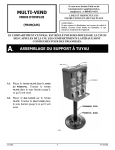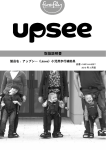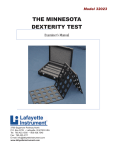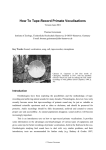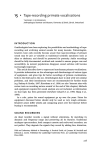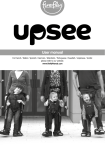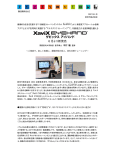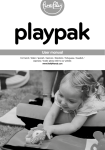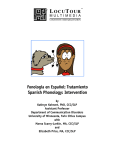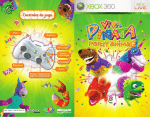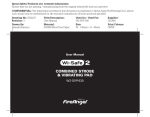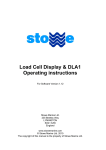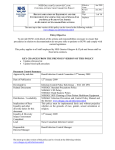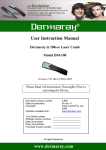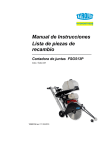Download Upsee Therapy Programme
Transcript
Therapy Programme A parent’s guide to choosing activities for improving Mobility, Ability & Participation (MAP) -1- Contents Section One Introduction to the Upsee Section Three Resources • What is the Upsee? • ICF-CY and MAP • Three starting essentials • Therapy terms explained •P utting on and taking off your Upsee •M AP Mobility Assessment Sheet (and guidance notes) •M AP Activity Programme Worksheets Section Two The Upsee Therapy Programme •A dditional Ability and Participation activity suggestions •W hat is the Upsee Therapy Programme? • MAP Ability Assessment • Overview • References • Contact details •F inding your child’s mobility starting point •C hoosing Ability and Participation activities • How to review your progress •S haring your progress with us at Firefly • Top tips -2- -3- SECTION 1 INTRODUCTION TO THE UPSEE Let’s get ready! With your Upsee, you can begin to provide different opportunities for developing your child’s mobility, ability and participation skills using our Upsee Therapy Programme. Of course, you can choose to simply place your child in the Upsee and move around – many families love to do this. However, the longest lasting benefits are gained by taking things a little more slowly. Letting your child take their own weight and allowing them to make the movements themselves means that they are actively learning and developing. In this booklet, we provide you with help and guidance from our qualified Physical and Occupational Therapists to support you to get the most out of your Upsee. -4- -5- The Upsee allows you to help your child to stand and move What is the Upsee? The Upsee is a mobility device designed to allow children with movement delays to stand and move with the help of an adult. It was invented by Debby Elnatan, a special needs mum from Israel, whose son has cerebral palsy. Many years ago, Debby was told by health professionals that her son had no awareness of his legs. Shocked by this, Debby tried to walk him by herself - a difficult task which led to her idea for the Upsee. She searched for a company to make her product and chose Firefly by Leckey. Firefly is a division of Leckey (www.leckey.com), a company known worldwide for making postural equipment for children with special needs. However, Firefly’s unique focus is special needs family participation, which provides a perfect match for the Upsee. The Upsee went viral online when it was launched and the response from families was amazing. Encouraged by this, we continued to listen carefully to what families had to say about the Upsee. That’s why our expert Physical and Occupational Therapists devised the Upsee Therapy Programme - to promote the use of the Upsee for therapy as well as family participation. Watch Debby tell her own story on Youtube: bit.ly/debby-elnatan -6- -7- Before you start Before attempting to use the Upsee for therapy or family participation activities, you must be able to answer ‘yes’ to ALL THREE questions below: Does your child already use a standing or walking frame? (Is your child already in a standing or walking programme?) When standing, are your child’s shoulders below your navel/belly-button? (Your child’s height in relation to you is important for safety) Can you and your child both stand upright while using the Upsee? (Make sure your body shape doesn’t alter your child’s posture) If you answered ‘no’ to even one of these questions, the Upsee is not suitable for your child. We also don’t recommend the Upsee if: •Y our child has very tight muscles •Y our child has a medical condition where they might need laid down quickly for treatment (for example, seizures) •Y our child has had more than one broken leg bone (due to brittle bones, for example) •Y our child’s hips and knees are fixed in a bent position •Y our child has major postural differences between the left and right sides of their body • You are expecting a baby •Y ou have or have had lower back pain If you have any doubts about your child’s suitability for the Upsee, it’s best to check with your therapist, or you can contact us using our details at the end of this booklet. FOR MORE ASSESSMENT AND PRESCRIPTION INFORMATION, CHECK OUT OUR ‘USEFUL DOWNLOADS’ SECTION AT www.fireflyfriends.com/ therapists/product-guide/upsee PARENTS THERE IS A VIDEO AVAILABLE FOR YOU TO WATCH AT bit.ly/upsee-assessment-prescription -8- -9- Putting on and taking off your Upsee Once you are sure the Upsee is suitable for your child, you are ready to get going! Getting used to putting on and taking off your Upsee can take a bit of practice, so please take the time to read the information in the Upsee User Manual and watch the instructional videos online at www.fireflyfriends.com/upsee Make sure your child is wearing comfortable clothing, trousers and footwear before putting them in the Upsee, and if they usually wear ankle splints (AFOs) for weight bearing activities, these should be put on too. Watch our instructional videos at www.fireflyfriends.com/upsee & read the Upsee User Manual in your Upsee box User manual For French / Italian Remember that if you or your child experiences any discomfort when using the Upsee, stop immediately. If the discomfort continues, contact your doctor. - 10 - - 11 - / Portuguese an / Mandarin / Spanish / Germ our website. please refer to ds.com www.fireflyfrien ese / Arabic / Swedish / Japan SECTION 2 THE UPSEE THERAPY PROGRAMME What is the Upsee Therapy Programme? The Upsee Therapy Programme provides a series of carefully selected activities which can contribute to your child’s development. There are three key areas of the programme: Mobility (M), Ability (A) & Participation (P). This is the MAP: MOBILITY is your child’s ability to access their world and gain as much independence as possible; ABILITY refers to all aspects of your child’s physical, cognitive and social development; PARTICIPATION is about enabling your child to experience as many activities as possible. The Upsee Therapy Programme consists of the MAP Mobility Assessment, and the MAP Activity Programme to work on mobility, ability and participation. DID YOU KNOW? THE MAP MODEL IS BASED ON THE WORLD HEALTH ORGANISATION’S ICF-CY FRAMEWORK. As the Upsee is primarily a mobility device, the MAP Mobility Assessment is the starting point of the Upsee Therapy Programme. There are also activity suggestions for ability and participation depending on your child’s current stage of development, and details on how to review and record your progress. TURN TO THE RESOURCE SECTION AT THE BACK FOR MORE INFO. - 12 - - 13 - Overview of the Upsee Therapy Programme Finding your child’s mobility starting point Using the MAP Mobility Assessment YOUR UPSEE ARRIVES! FIND YOUR CHILD’S MOBILITY STARTING POINT USING THE MAP MOBILITY ASSESSMENT REPEAT AT REGULAR INTERVALS, FOR EXAMPLE, ONCE PER MONTH READ THE INSTRUCTIONS AND PRACTICE USING THE UPSEE REMEMBER TO RECORD YOUR CHILD’S STAG E S AND GOALS It is important to understand your child’s current stage as well as their limitations, because this helps you figure out what stage to work on next. Your child’s mobility starting point is simply what your child is able to do at this moment in time, both in the Upsee and out of the Upsee. You know your child better than anyone, so along with the MAP Mobility Assessment you (and your therapist if possible) will be able to work out their starting point. Remember that all children are different and your child’s starting point may not be the same as that of other children. Our MAP Mobility Assessment (see resources) helps you to decide your child’s mobility starting point in the Upsee. It contains three Mobility Goals and the stages designed to help your child progress as much as they are able. The three Mobility Goals are: CHOOSE MOBILITY, ABILITY & PARTICIPATION ACTIVITIES TO WORK ON USING THE MAP ACTIVITIES WORKSHEETS DON’T OVERDO IT! TRY TO PRACTICE ACTIVITIES LITTLE AND OFTEN HEAD CONTROL WEIGHTBEARING ADDITIONAL BLANK MOBILITY ASSESSMENT SHEETS ARE AVAILABLE IN THE ‘USEFUL DOWNLOADS’ SECTION AT www.fireflyfriends.com/ therapists/product-guide/upsee RECORD PROGRESS USING THE MAP MOBILITY ASSESSMENT AND OPTIONAL MAP ABILITIES ASSESSMENT - 14 - WALKING THESE MAY BE USEFUL FOR THERAPISTS WHO WOULD PREFER TO CREATE ALTERNATIVE MOBILITY GOALS FOR YOUR CHILD. - 15 - The stages of each Mobility Goal are a bit like building blocks, each one supporting the next. For example, for weight bearing, the stages build from no weight bearing to consistently weight bearing: STAGES DATE MOBILITY GOAL 2: WEIGHT BEARING Once you know what your child can currently do in the Upsee for each Mobility Goal, you can choose to aim for the next stage or maintain the stage your child is currently at. To use the weight bearing example again, if your child shows flickers of weight bearing while in the Upsee (their current stage is STAGE 2 – shaded yellow on the example), you can work towards weight bearing continuously for up to 30 seconds (STAGE 3 – shaded pink in the example). STAGE 1 No weight bearing STAGE 2 Flickers of weight bearing STAGE 3 Weight bearing continuously for 5-30 seconds STAGE 4 Weight bearing continuously for more than 30 seconds but less than 2 minutes STAGE 1 No weight bearing STAGE 5 Maintains symmetrical weight bearing through legs STAGE 2 Flickers of weight bearing STAGE 3 Weight bearing continuously for 5-30 seconds STAGE 4 Weight bearing continuously for more than 30 seconds but less than 2 minutes STAGE 5 Maintains symmetrical weight bearing through legs To decide which stage your child is currently at in each of the three Mobility Goals, use the Upsee for a couple of short sessions to judge their response. Remember you can refer to the Upsee User Manual, online instructional videos and the guidance notes on the MAP Mobility Assessment to help you. Then, use the MAP Mobility Assessment to identify which stage most closely matches your child’s activity in the Upsee for each Mobility Goal, and record the date. STAGES DATE MOBILITY GOAL 2: WEIGHT BEARING 10.10.15 DID YOU KNOW? THE RIGHT EQUIPMENT AND THERAPY THAT ENCOURAGES MOBILITY HAS BEEN SHOWN TO PREVENT OR SLOW DOWN SECONDARY DEFORMITIES - 16 - - 17 - 1 Choosing ability and participation activities using the MAP Activities Programme ility starting your child’s Mob d un fo ve ha u , find the Now that yo Mobility Goals e re th e th of ion. There are point for each resources sect e th in al go at th ver work worksheet for ill probably ne w u yo t bu l, ta s in to pending on the five worksheet y one time, de an at e re th an on more th is at. ed stage your child heet are design on each works ns tio es gg ng su ki ty or The mobili , so if you are w ork on that goal w to help lly ca ifi ec sp suggestions will ty ili ob m e th g, in the ability and on weight bear However, lots of g. in ar be t gh ei be mixed and with w ggestions can su ity as tiv ac n io ch worksheet, participat erapy tips on ea th d fin n. ill io w ct u se matched. Yo in the resource neral ‘top tips’ ge of psee t U lis a ur yo as l wel t out of to get the mos u yo lp he ill w These mme. Therapy Progra ities are rticipation activ pa d an ty ili ab , to choose Lists of mobility Don’t be afraid n. io ct se ce ur ation. reso included in the d family particip an ild ch ur yo r best fo choose, it’s best ones that work ch activities to hi w t ou ab re ntact us using If you are unsu You can also co t. is ap er th ur yo ck page. if you speak to ovided on the ba pr ils ta de t ac the cont DID YOU KNOW? EVIDENCE SUGGESTS THAT PROVIDING FAMILY-CENTRED CARE CAN IMPROVE A CHILD’S DEVELOPMENT AND DECREASE PARENTAL STRESS - 18 - - 19 - 2,3 Remember! Progress in the Upsee will vary a great deal from child to child – some going much faster than others. It depends on many things, including their underlying health condition and how regularly you use the Upsee. Your child will benefit from the experience of standing with you, which may be the best they can do at this stage in their development. For some children, maintaining a stage is an achievement in itself. Don’t be tempted to exaggerate or over-estimate the stage your child is at, even if they are close to the next stage. Be realistic, and then you can be sure that when progress occurs, it’s the real deal. How to review your progress It’s useful to try to review your child’s progress because it: •H elps you understand any effects that the Upsee may have on your child’s development; •K eeps you focused on encouraging your child to achieve the next stage; •H elps you look back and remember how far your child has come, especially if you take photographs and/or videos as you go along. If things aren’t going to plan don’t lose heart! Keep a record of the stage your child is at and take a break, or go back to an easier stage if you need to. AT THE HEART OF THE FUN Read about other families’ Upsee stories at: www.fireflyfriends.com/ therapists/case-histories/upsee EXPL ORING NEW WORL A WHOL E D - 20 - Look back and remember how far your child has come. A NEW GETTING TIVE C PERSPE - 21 - How to review your progress using the MAP Mobility Assessment and optional MAP Ability Assessment As the Upsee concentrates primarily on mobility, you can use the MAP Mobility Assessment to review your child’s progress. After about a month, simply repeat the process of assessment and check how your child is doing against the stages for each goal. If your child has reached a new stage, write the date beside it. You are then aiming for the next stage, as you did before. If your child hasn’t quite reached the next stage, don’t worry, just keep going and review again in another month, or whenever you feel your child has made progress. Optional MAP Ability Assessment Sharing your progress with us at Firefly We’d love to hear how you and your child are getting on with your Upsee Therapy Programme, especially if you’ve completed one or two reviews. Going by the stories we have heard from families through Facebook and Twitter, we believe that the Upsee can benefit children in a number of ways. However, it’s really difficult to show this because families share their stories in so many different ways. The Upsee Therapy Programme provides families, not only with a therapy tool, but a system for recording progress, which means we can compare stories. And if we can show patterns, we can more reliably demonstrate the benefits of the Upsee to families and their therapists. So, if you’d like to be part of this bigger picture, please email your reviews to [email protected] Some parents have reported unexpected changes in their child’s abilities (for example, hand function or confidence), which they believe are related to using the Upsee. If you notice additional changes, try to capture these using the MAP Abilities Assessment (see resources). This will help to give you a much more rounded picture of your child’s progress. Simply choose whether you feel your child’s skills in the six ability areas (hand function, floor play, communication, attention, exploration and fun) are (a) worse than before you started using the Upsee; (b) the same as before; or (c) better than before. Make a note of any specific changes you have noticed, and try to describe what is different. - 22 - - 23 - Top Tips Contact Us Choose a time when your child is well rested and ready for play for your Upsee session. After eating, try to wait at least 30 minutes before using the Upsee, and avoid using it before bed. Stand for a short time (around 2 minutes) to begin with and increase the time in the Upsee gradually, going at your child’s pace. Use a mirror to check that the Upsee is fitting both you and your child correctly and to review your progress, e.g. regarding posture, head control, trunk control, etc. If you have any questions or would like to provide feedback, you can contact us at: Phone: +44 (0) 28 92 600750 Email: [email protected] Address: F irefly by Leckey, 19C Ballinderry Road, Lisburn, Northern Ireland, BT28 2SA Encourage your child to initiate their own steps and/or the direction of movement. Try to make the experience fun for everyone involved – include brothers, sisters, friends and use toys, music or everyday tasks (e.g. getting something from the fridge) to encourage your child in the Upsee. Keep an eye on your child’s confidence before and after using the Upsee and note how much your child is enjoying the Upsee session. Note how much your child is motivated to use the Upsee before using it, and how much your child is motivated to do activities in the Upsee. Take photographs and videos as you go along, remembering to note the date – they form a really helpful part of your review. - 24 - - 25 - SECTION 3 RESOURCES ICF-CY and MAP Explained The International Classification of Functioning, Disability and Health for Children and Youth (ICF-CY) is an internationally recognised framework which is designed “to record the characteristics of the developing child and the influence of its surrounding environment.” (World Health Organisation, 2007). This means that health and function are emphasised, and disability or difficulties with function are viewed simply as part of the overall health spectrum. The focus is balanced between what children and young people are able to do, as well what they have difficulty with. The overall model is below: Health Condition Body Functions and Structures Activities Environmental Factors Participation Personal Factors International Classification of Functioning, Disability and Health Framework for Children and Youth (WHO, 2007). - 26 - - 27 - The health condition is generally considered the child’s diagnosis – this could equally be ‘asthma’ or ‘cerebral palsy’. Body structures and functions relate to the health condition and describe what is wrong with the body. This may be wheezing (for asthma), or high muscle tone (for cerebral palsy). The body functions and structures affect the child’s activity. Does the child become short of breath? Can the child rise to stand and walk? What is the child capable of doing? Activity impacts on the child’s level of participation in everyday activities such as playing, eating, dressing, cycling, going to the shops, involvement in sports etc. Alongside these factors is the acknowledgement that the child’s environment and individual personal factors influence their development. Parents, siblings, motivation, cognitive ability, housing, infrastructure of local health and education services, and access to sports and leisure facilities are a few of the environmental and personal factors that may impact on a child’s development in each area. Research suggests that therapy which looks at multiple areas appears to be more beneficial than a single treatment approach. Therefore, interventions should target body functions and structures, activities and participation, as well as environmental and personal factors (Chiarello & Kolobe, 2006). Firefly At Firefly by Leckey, our vision is to create a world where every child with special needs can enjoy a childhood filled with play, participation and possibilities. Working with the community of parents and therapists we will campaign for change and co-create unique, innovative, life changing products. We recognise that we are not able to change a child’s health condition or environment, but by using Firefly products, we believe we can have an influence on their body structures, activities and participation. So, we have developed our own MAP framework to reflect where we can help. The MAP The MAP is Firefly and Leckey’s own framework for understanding how products can help children with disabilities. With the child, their family and the products at the centre of the model, their developmental progress is influenced by mobility, ability and participation. For example, by using a product to stretch muscles (body functions and structures in the ICF-CY), we may actually improve mobility which we define as a child being able to access their world and gain as much independence as possible. And of course, products which move will encourage mobility too! A product might encourage a child to develop hand function, concentration or communication (activities in the ICF-CY). We have termed this ability, which we define as improving physical, cognitive and social development. - 28 - - 29 - Similarly to the ICF-CY, we have defined participation as being able to experience as many activities as possible. Therapy terms explained The MAP Model is below: GROSS MOTOR SKILLS INITIATION Large movements usually related to developmental milestones e.g. rolling, sitting, crawling, cruising and walking. The ability to start a movement and/ or the direction of movement. ENGAGEMENT REACH Obvious enjoyment from taking part in an activity. Part of gross motor skills, stretching arms to reach across the body, upwards or downwards. MOTIVATION Eagerness to take part in an activity and responds positively. May become upset when it’s time to finish. FINE MOTOR SKILLS Small movements usually related to hand function e.g. pincer grasp, ability to hold a crayon, manage cutlery, or buttons etc. COMMUNICATION The ability to listen and respond through facial expressions, gestures, sounds or words. BILATERAL HAND FUNCTION TRACKING (VISION) Part of fine motor skills using both hands together to hold, throw, catch, build, open etc. The ability to follow a stimulus using the eyes, with or without moving the head. VISUAL-MOTOR SKILLS EVERYDAY ACTIVITIES The ability to co-ordinate eyes and movements. Visual-motor skills affect the ability to kick a ball (eye-foot co-ordination), pick up a block (eyehand co-ordination), or drink from a cup (hand-mouth co-ordination). Activities that people do on a dayto-day basis e.g. walking, brushing teeth, setting the table. BODY AWARENESS The ability to recognise body parts and know where they are in relation to other body parts or surroundings without having to look. MAP (©Leckey 2015) CONFIDENCE Self-assured and willing to try new things. - 30 - - 31 - SENSORY SKILLS The ability to process information (e.g. light/dark, hot/cold, rough/ smooth, noisy/quiet) using the senses to understand the world and carry out everyday activities more easily. Getting prepared Choose a time when both of you have time so you don’t have to rush. Put on the Upsee according to the Upsee User Manual and online instructional videos. Stand up slowly and adjust the Upsee straps as explained. You do not have to move at this stage. Simply stand and watch your child’s reaction for the three mobility goals. You may find it better to have a couple of trials in the Upsee to reduce the chance of having an ‘off day’ in the Upsee. Assessing for Mobility Goal 1: Head Control Give your child a moment or two to get used to the Upsee. If their head control is poor, watch what happens when you stand up in the Upsee. Does their head hang down, even with encouragement from you or exciting toys held out in front? If so, select Head Control Stage 1. You will be aiming for Head Control Stage 2. Does your child try to lift their head, even just a little, with your encouragement before it falls down again? If so, you can select Head Control Stage 2 and your goal is Head Control Stage 3. If your child is able to hold their head upright for a short time, count how long they can do this for. You will then select Head Control Stage 3 or Head Control Stage 4 and be aiming for Head Control Stage 4 or Head Control Stage 5. If your child has full head control, you can select Head Control Stage 5 and this will be the stage which you maintain for your child. - 32 - - 33 - Assessing for Mobility Goal 2: Weight Bearing Assessing for Mobility Goal 3: Walking Pattern Give your child a moment or two to get used to the Upsee. Stand in the Upsee and sway a little from side to side. You will be able to feel if your child is hanging in the harness (Weight Bearing Stage 1) or bearing weight through their own feet (Weight Bearing Stage 2 - Stage 5). Only select Weight Bearing Stage 5 if your child is able to take the same amount of weight through each leg, and this is the stage which you will maintain for this goal. Give your child a moment or two to get used to the Upsee. Begin to take a few small steps with your child. Move slowly and remember to modify your own step height and length to match your child’s movement (see the Upsee User Manual and online instructional videos). Walking Pattern 3a: Full help from adult G TO LEARNIN BEAR WEIGHT - 34 - If your child refuses to move, or clearly dislikes walking in the Upsee, select Walking Pattern 3a Stage 1 and try just standing, to allow your child to get used to the Upsee harness. If your child needs your help through the whole walking movement, select Walking Pattern Stage 2 – Stage 5, depending on how much they can do. If your child is able to manage Walking Pattern 3a Stage 5, you are aiming for Walking Pattern 3b Stage 1. - 35 - Walking Pattern 3b: Some help from adult This means that you will be able to feel whether your child takes over the stepping movement once you start. Select Walking Pattern 3b Stage 2 - Stage 5 as appropriate. If your child manages Walking Pattern 3b Stage 5, you are aiming for Walking Pattern 3c Stage 1. Walking Pattern 3c: Without sandals If you feel your child wants to take the lead in stepping, take the sandals off and see how they get on. Select the appropriate stage and aim for the next one. Walking Pattern 3c Stage 5 is the maintenance stage for this goal. - 36 - - 37 - MAP Mobility Assessment We would love to hear about your progress - send your reviews, photos and videos to: upsee.programme @fireflyfriends.com* STAGES MOBILITY GOAL 3A: WALKING PATTERN WITH FULL HELP FROM ADULT *see page 57 for specific guidance Your child’s name: Date of birth: Diagnosis: Date of assessment/review: STAGES DATE DATE STAGE 1 Not able to take any steps with full help STAGE 2 Can take 5-10 steps with full help STAGE 3 Can take 11-20 steps with full help STAGE 4 Can take 21-50 steps with full help STAGE 5 Maintains stepping pattern with full help MOBILITY GOAL 1: HEAD CONTROL STAGES DATE MOBILITY GOAL 3B: WALKING PATTERN WITH SOME HELP FROM ADULT STAGE 1 Not able to lift head STAGE 2 Lifts head but unable to achieve upright position over body STAGE 1 Not able to take any steps with some help STAGE 3 Able to lift head to upright position for 5-30 seconds STAGE 2 Can take 5-10 steps with some help STAGE 4 Holds head in upright position for more than 30 seconds but less than 2 minutes STAGE 3 Can take 11-20 steps with some help STAGE 5 Maintains head in upright position STAGE 4 Can take 21-50 steps with some help STAGE 5 Maintains stepping pattern with some help STAGES DATE STAGES MOBILITY GOAL 2: WEIGHT BEARING DATE MOBILITY GOAL 3C: WALKING PATTERN WITHOUT SANDALS STAGE 1 No weight bearing STAGE 2 Flickers of weight bearing STAGE 3 Weight bearing continuously for 5-30 seconds STAGE 4 Weight bearing continuously for more than 30 seconds but less than 2 minutes STAGE 5 Maintains symmetrical weight bearing through legs - 38 - STAGE 1 Unable to achieve any steps without sandals STAGE 2 Can take 5-10 steps without sandals STAGE 3 Can take 11-20 steps without sandals STAGE 4 Can take 21-50 steps without sandals STAGE 5 Maintains stepping pattern without sandals - 39 - MAP ACTIVITY PROGRAMME WORK SHEET FOR SEE ACTIVITY SUGGESTIONS IN THE HEAD CONTROL FOLLOWING PAGES TO CHOOSE OTHER ABILITY AND PARTICIPATION ACTIVITIES FOR YOUR CHILD. THE SPECIFIC HEAD CONTROL STAGE WE ARE WORKING ON IS: M POSITIONS & TIPS FOR IMPROVING MOVEMENT AND INDEPENDENCE MOBILITY ACTIVITIES •U se your hands to move your child’s head up slowly and gently, hold for a few seconds, and lower your child’s head slowly and gently. •G ive some support to your child’s shoulders from the front to encourage active movement. •K eep your hold light and feel for any active movement your child makes towards head lift. IN GENERAL, LEG AND TRUNK ACTIVITY PROMOTE HEAD LIFT. A ACTIVITIES FOR IMPROVING PHYSICAL, COGNITIVE AND SOCIAL DEVELOPMENT P ACTIVITIES THAT ENABLE AS MANY EXPERIENCES AS POSSIBLE ABILITY ACTIVITIES •Y ou can adapt most ability activities for working on head control by changing their height. Use your imagination to lift things up to eye level! • Place magnetic shapes on the fridge door. • Draw or paint at an easel. • Put cutlery into a kitchen drawer. PARTICIPATION ACTIVITIES CHOOSE ABILITY & PARTICIPATION ACTIVITIES WHICH ENCOURAGE YOUR CHILD TO LOOK UP. •A s head control improves, you can do more difficult things. •S tand in front of a long mirror, and sing action songs. • Look out of a tall window. •P lay turn-taking games with a sibling or friend, for example, Pin the Tail on the Donkey, or piñata. - 40 - - 41 - MAP ACTIVITY PROGRAMME WORK SHEET FOR WEIGHT BEARING THE SPECIFIC WEIGHT BEARING STAGE WE ARE WORKING ON IS: M POSITIONS & TIPS FOR IMPROVING MOVEMENT AND INDEPENDENCE SEE ACTIVITY SUGGESTIONS IN THE FOLLOWING PAGES TO CHOOSE OTHER ABILITY AND PARTICIPATION ACTIVITIES FOR YOUR CHILD. MOBILITY ACTIVITIES • Start in a standing position facing a mirror. •S tand and sway slowly from side to side, giving your child the chance to be active; build this and encourage your child to reach in all directions. • If your child bears weight through one leg more than another, lean and encourage them to reach more to the side which bears less weight or place the foot which normally bears more weight onto a low step. IN GENERAL, ACTIVE WEIGHT BEARING THROUGH THE LEGS REGULATES MUSCLE TONE. ENCOURAGE BOTH FEET TO BE FLAT AND WEAR AFOS. A ACTIVITIES FOR IMPROVING PHYSICAL, COGNITIVE AND SOCIAL DEVELOPMENT ABILITY ACTIVITIES •Y ou can adapt most ability activities for working on weight bearing by changing them to standing activities. Use play to encourage your child to shift their weight from side to side. •S tand at a table to play, watch television or use an iPad, rather than sit. • Play with sand, water or paint. • Kick a balloon or ball. AS WEIGHT BEARING IMPROVES, LOOSEN SHOULDER STRAPS A LITTLE (ABOUT 1CM/0.5”) P ACTIVITIES THAT ENABLE AS MANY EXPERIENCES AS POSSIBLE PARTICIPATION ACTIVITIES TO ENCOURAGE TRUNK BALANCE. •A s weight bearing improves, you can do more difficult things. • Play shopkeeper with a friend. • Play throw and catch with a balloon or ball. • Dance to slow tempo music. - 42 - - 43 - MAP ACTIVITY PROGRAMME WORK SHEET FOR WALKING PATTERN (WITH FULL HELP) SEE ACTIVITY SUGGESTIONS IN THE FOLLOWING PAGES TO CHOOSE OTHER ABILITY AND PARTICIPATION ACTIVITIES FOR YOUR CHILD. THE SPECIFIC WALKING PATTERN STAGE WE ARE WORKING ON IS: M POSITIONS & TIPS FOR IMPROVING MOVEMENT AND INDEPENDENCE MOBILITY ACTIVITIES •T ry one step very slowly to let your child feel the movement. Then try a second step with the other foot. Step forwards and back with one leg, then the other. Step sideways and back with one leg, then the other. •P lace one foot on a very low step in front of the other foot. Rock backwards and forwards over your legs. •A s you build tolerance, try to make sure your child’s step length is even for left and right legs. A ACTIVITIES FOR IMPROVING PHYSICAL, COGNITIVE AND SOCIAL DEVELOPMENT IT MAY TAKE A WHILE FOR YOUR CHILD TO GET USED TO MOVING IN THE UPSEE. DON’T OVERDO IT OR LET THEM GET TOO TIRED. ABILITY ACTIVITIES •Y ou can adapt most walking activities by changing the location and duration of your walk. Use short steps with your feet slightly apart. You need to take smaller, wider steps than usual to go at your child’s pace. • Set the table. • Play hide and seek. ENCOURAGE YOUR CHILD TO LOOK FOR TOYS P ACTIVITIES THAT ENABLE AS MANY EXPERIENCES AS POSSIBLE PARTICIPATION ACTIVITIES AND OBJECTS IN DIFFERENT DIRECTIONS. •A s walking with full help improves, you can do more difficult things. • Cook or bake together. • Walk through fallen leaves. • Dance to up tempo music. - 44 - - 45 - MAP ACTIVITY PROGRAMME WORK SHEET FOR SEE ACTIVITY SUGGESTIONS IN THE WALKING PATTERN FOLLOWING PAGES TO CHOOSE OTHER ABILITY AND PARTICIPATION ACTIVITIES (WITH SOME HELP) FOR YOUR CHILD. THE SPECIFIC WALKING PATTERN STAGE WE ARE WORKING ON IS: M POSITIONS & TIPS FOR IMPROVING MOVEMENT AND INDEPENDENCE MOBILITY ACTIVITIES • Wait and feel for your child initiating stepping in different directions and go with them when this happens. This will improve motivation and a sense of purpose in stepping for your child. • Try counting or using rhymes to keep a steady rhythm. IT MAY TAKE A WHILE FOR YOUR CHILD TO GET USED TO MOVING IN THE UPSEE. DON’T OVERDO IT OR LET THEM GET TOO TIRED. A ACTIVITIES FOR IMPROVING PHYSICAL, COGNITIVE AND SOCIAL DEVELOPMENT P ACTIVITIES THAT ENABLE AS MANY EXPERIENCES AS POSSIBLE ABILITY ACTIVITIES • You can adapt most walking activities by changing the location and duration of your walk. • Play football using a balloon or ball. • Help to tidy up. • Blow bubbles and chase them. PARTICIPATION ACTIVITIES • As walking with some help improves, you can do more difficult things. • Help with the gardening. ENCOURAGE YOUR CHILD TO USE THEIR HEAD OR HANDS TO POINT TO SHOW THE DIRECTION THEY WANT TO GO. • Go for a walk on the beach. • Help to wash the car. - 46 - - 47 - MAP ACTIVITY PROGRAMME WORK SHEET FOR SEE ACTIVITY SUGGESTIONS IN THE WALKING PATTERN FOLLOWING PAGES TO CHOOSE OTHER ABILITY AND PARTICIPATION ACTIVITIES (WITHOUT SANDALS) FOR YOUR CHILD. THE SPECIFIC WALKING PATTERN STAGE WE ARE WORKING ON IS: M POSITIONS & TIPS FOR IMPROVING MOVEMENT AND INDEPENDENCE MOBILITY ACTIVITIES • If your child has shown the ability to take well placed steps with the sandals on, try walking without sandals. • Guide your child’s foot position to achieve a normal foot placement. • Give your child time to initiate stepping and movement forwards, backwards and sideways. AVOID RUSHING YOUR CHILD AND DON’T STEP BEFORE THEY ARE READY TO GO – WAIT FOR THEIR ACTIVE INVOLVEMENT. A ACTIVITIES FOR IMPROVING PHYSICAL, COGNITIVE AND SOCIAL DEVELOPMENT P ACTIVITIES THAT ENABLE AS MANY EXPERIENCES AS POSSIBLE ABILITY ACTIVITIES • You can adapt most walking activities by changing the location and duration of your walk. • Dressing up. • Play skittles or bowling. • Play mini golf. PARTICIPATION ACTIVITIES • As walking without sandals improves, you can do more difficult things. PLAY INVOLVES MAKING CHOICES, AND USING THE UPSEE SHOULD ENABLE YOUR CHILD TO ACCESS THEIR CHOICES. • Walk down a gentle slope. • Take the dog for a walk. • Paddle in the sea or paddling pool. - 48 - - 49 - NOTE: MANY ACTIVITIES CAN ADDRESS ALMOST ALL THE ABILITY AREAS WITH SOME THOUGHT. THE DOTS ( ) LISTED CAPTURE THE MAIN BENEFITS OF EACH ACTIVITY, BUT THERE ARE MANY OVERLAPS. FOR EXAMPLE, TALKING YOUR CHILD THROUGH YOUR CHOSEN ACTIVITY INCLUDES COMMUNICATION IN EVERY CASE. Ability Activity Suggestions GROSS MOTOR SKILLS ACTIVITY SUGGESTIONS REACH FINE MOTOR SKILLS BILATERAL HAND FUNCTION VISUAL MOTOR SKILLS COMMUNICATION EVERYDAY ACTIVITIES SENSORY SKILLS BALL PLAY BRUSH TEETH/HAIR BUILDING BLOCKS CHOOSE CLOTHES CLAPPING HANDS TO SONG/CLAPPING GAMES CLEAN THE TABLE DO THE WASHING UP DRAWING AT THE TABLE DRESSING - ZIPS AND BUTTONS FOLLOW TOYS WITH EYES GETTING ITEMS FROM CUPBOARDS, FRIDGE ETC. JIGSAWS PASS OBJECT FROM ONE HAND TO ANOTHER PICKING UP SMALL OBJECTS E.G. LEGO PIECES, BEADS ETC. PIN THE TAIL ON THE DONKEY PLAY-DOH POINT AND NAME OBJECTS POINT AT OBJECTS TO ENCOURANGE LOOKING Continued overleaf... - 50 - - 51 - NOTE: MANY ACTIVITIES CAN ADDRESS ALMOST ALL THE ABILITY AREAS WITH SOME THOUGHT. THE DOTS ( ) LISTED CAPTURE THE MAIN BENEFITS OF EACH ACTIVITY, BUT THERE ARE MANY OVERLAPS. FOR EXAMPLE, TALKING YOUR CHILD THROUGH YOUR CHOSEN ACTIVITY INCLUDES COMMUNICATION IN EVERY CASE. Ability Activity Suggestions continued GROSS MOTOR SKILLS ACTIVITY SUGGESTIONS REACH FINE MOTOR SKILLS BILATERAL HAND FUNCTION VISUAL MOTOR SKILLS COMMUNICATION POPPING BUBBLES PUSHING PASTA/BEADS ETC. INTO PLAY-DOH ROLL PLAY-DOH INTO BALLS SET THE TABLE SIMON SAYS SKITTLES/BOWLING SORTING TOYS BY COLOUR SORTING TOYS BY SIZE SQUEEZING BOTTLES TABLE TOP SAND PLAY TEARING AND STICKING PAPER THROW AND CATCH A BALLOON, BALL, BEANBAG ETC. TOUCHING OBJECTS OF DIFFERENT TEXTURES USE ROLLING PIN FOR COOKING OR PLAY-DOH USING UPSEE IN BRIGHT/DARK AREAS USING UPSEE IN QUIET/NOISY AREAS USING UPSEE WITH SLOW/FAST MUSIC - 52 - - 53 - EVERYDAY ACTIVITIES SENSORY SKILLS Participation Activity Suggestions Art Ball games Cooking/baking Dancing Fishing Football Games, e.g. ‘Hide and Seek’ N AT Gardening G FU G ZOO N I V IN HA PETT Golf THE Household chores, e.g. ‘Tidy Up’ Imaginative games, e.g. ‘Shop’ Paddling pool Playing indoors with friends Playing outdoors with friends Seaside/beach Walks FUN F THE OR AL L FAM ILY LEARNING ABOUT DINOSAUR S - RAAA AR! THE Y AT F! A D GOL FUN ZY CRA - 54 - - 55 - We would love to hear about your progress - send your reviews, photos and videos to: upsee.programme @fireflyfriends.com* MAP Ability Assessment *see page 57 for specific guidance Your child’s name: We love seeing and hearing about your progress using Upsee. It really helps us advise and guide other parents and therapists within the community, and helps them decide if the Upsee is suitable for them and their child or client. Date of birth: Diagnosis: Date of assessment: Ability Area Please share your progress Worse than before Same as before Better than before It would be great if you could send: Your Comments (describe any differences you have noticed) Photos or scans* of three successive reviews using the Mobility Assessment Sheets (covering a minimum period of 2 months) Photos or videos demonstrating the progress achieved at each review Hand function A photo or scan of one completed Ability Assessment Sheet Reaching, grasping, moving objects from hand to hand, using both hands together, feeding self or drinking. Photos and videos demonstrating each ability exercise you worked on Floor play You can send these to [email protected] Sitting balance, attempts to move around on floor, ability to move around on floor. *We love reviewing your photos and video footage. If possible, please send the highest resolution photos and videos you can. This really helps everyone. Thanks! References Communication Level of understanding, vocalising to show moods, use of words. 1. Skar L (2002). Disabled children’s perceptions of technical aids, assistance and peers in play situations. Scandinavian Journal of Caring Sciences; 16: 27-33. Attention 2. Berlin LJ, Brooks-Gunn J, McCartan C, McCormick MC (1998). The effectiveness of early intervention: examining risk factors and pathways to enhanced development. Preventative Medicine; 27: 238-245. Concentration on activities, level of motivation or confidence. 3. Ohgi S, Fukuda M, Akiyama T, Gima H (2004). Effect of an early intervention programme on low birth weight infants with cerebral injuries. Journal of Paediatric Child Health; 40: 689-695. Exploration Level of interest in people, surroundings, messy play, sensory activities with noise, lights or touch. 4. World Health Organisation (2007). International Classification of Functioning, Disability and Health: Children and Youth Version. Geneva: WHO. 5. Chiarello LA, Kolobe THA (2006). Early Intervention Services. In: Campbell S, Vander Linden DW, Palisano RJ (Eds) (2006). Physical Therapy for Children, 3rd Edition. Saunders Elsevier. Fun Level of happiness, enjoyment of others’ company, engagement in activities, smiling. - 56 - - 57 - If you have any questions or would like to provide feedback, you can contact us at: +44 (0) 28 92 600750 [email protected] Firefly by Leckey, 19C Ballinderry Road, Lisburn, Northern Ireland, BT28 2SA LS569-01 - 58 -






























